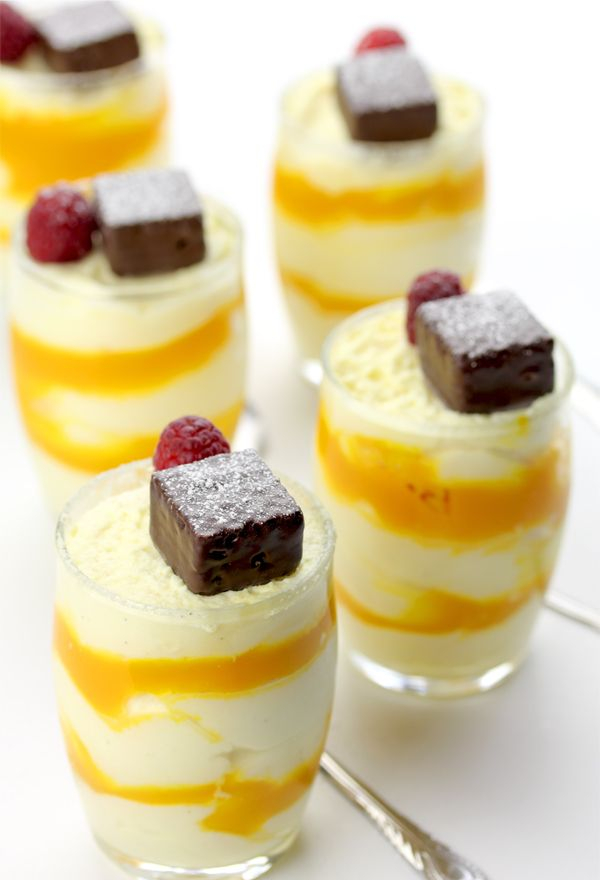Individual servings for dessert is a great way to end a fancy meal. I usually decorate dessert cups at the last minute, carry the tray filled with cups to the table so I’m able to chat and mingle with our guests without worrying about making a mess while serving the sweets. Last night, we hosted one more dinner party (I can’t believe it’s the second one in just a one-week period) and the dinner went fantastically well. It was a 4-course classical French menu, then we moved to another room to finish the meal with dessert. I also often try to give a little flavor of the muticultural aspect of our household by using exotic ingredients throughout the menu.
This time, I added guava and papaya pulp to parfait cups. The guava is amazingly fragrant and I used the papaya for its deep orange color. I accompanied the sweets with store-bought chocolate wafers and fresh raspberries for a touch of acidity.
1. Info for Guava Papaya Parfait Cups
- Cook Time: 30 mins
- Total Time: 50 min
- Servings: 12
- Calories: 68 kcal
2. Ingredients for Guava Papaya Parfait Cups
- 1 cup guava pulp, strained, seeds discarded
- 2 egg yolks
- 16 ounces mascarpone cheese
- 1/8 teaspoon salt
- 2 tablespoons rum (optional)
- 2½ cups heavy whipping cream
- 1 (3.5-ounce) package chocolate wafer cookies (or any chocolate cookies)
- 12 fresh raspberries, optional
3. Directions:
- Making guava papaya mousse:
- Place the guava and papaya in a small saucepan. Bring to a boil, add 1 tablespoon sugar then immediately lower the heat and simmer gently for a bit less than 5 minutes. Remove from the heat and let cool.
- In a stainless-steel mixing bowl, using an electric handheld mixer, whisk the eggs with ¼ cup sugar until the texture thickens. Make a “double boiler” (a pot filled with hot water, covered with a piece of cloth) and place the bowl filled with whisked eggs on top). Continue whisking the eggs at full speed for about 3-4 minutes. Check the temperature of the eggs; they should feel warm to the touch. Remove from the double boiler, add 2 tablespoons guava papaya mixture. Continue whisking at full speed for about 5 minutes. Make sure the eggs are whisked for a long time, so the mousse is light and airy. Strain the liquid through a fine mesh sieve into a bowl to remove any solids (zest and pulp). Let cool to room temperature, cover with plastic wrap and refrigerate for at least 30 minutes.
- Add a pinch of salt to the whipping cream. Whip the cream (at low speed) for 2-3 minutes until creamy and smooth. Add the rest of the powdered sugar. Increase to maximum speed and keep beating for another 2-3 minutes, until it forms soft peaks. Do not over-beat or the texture will become grainy.
- Pour 1/3 of the whipped cream into the chilled guava papaya custard. Mix well using a silicone spatula. Pour in the rest of the whipped cream; gently fold the cream into the custard to get an airy mousse.
- Assembly:
- Optional step: Add rum (if using) to the remaining guava papaya mixture. Mix well. Transfer to a syringe or pipe. Set aside.
- Transfer to the mousse to a piping bag.
- Pipe the mousse to fill 3-ounce dessert cups about one quarter way. Drizzle a ring of the rum fruit pulp mixture so it’s visible. Then, pipe one more layer of the guava-papaya mousse and repeat another level of the fruity, colorful ring. Level the mousse filling with a spatula if necessary (I didn’t).
- Plastic-wrap each individual cup and place in the refrigerator for at least 3 hours. The fat from the cream may pick up some other food odor from the refrigerator if the cups are not sealed properly.
- When you’re ready to serve, unwrap the cups and top with the chocolate wafer cookies and raspberries. Dust with a little powdered sugar (using a fine mesh strainer) if you like.
- Bon appétit!
4. Tips and advices:
- You can easily find guava and papaya in most Asian grocery stores, while in season, of course.
- I prefer using powdered sugar. It’s very fine and dissolves more quickly than regular granulated sugar.
- I usually add a little salt to most desserts. Salt brings out the flavors and will enhance the taste of your sweets.

